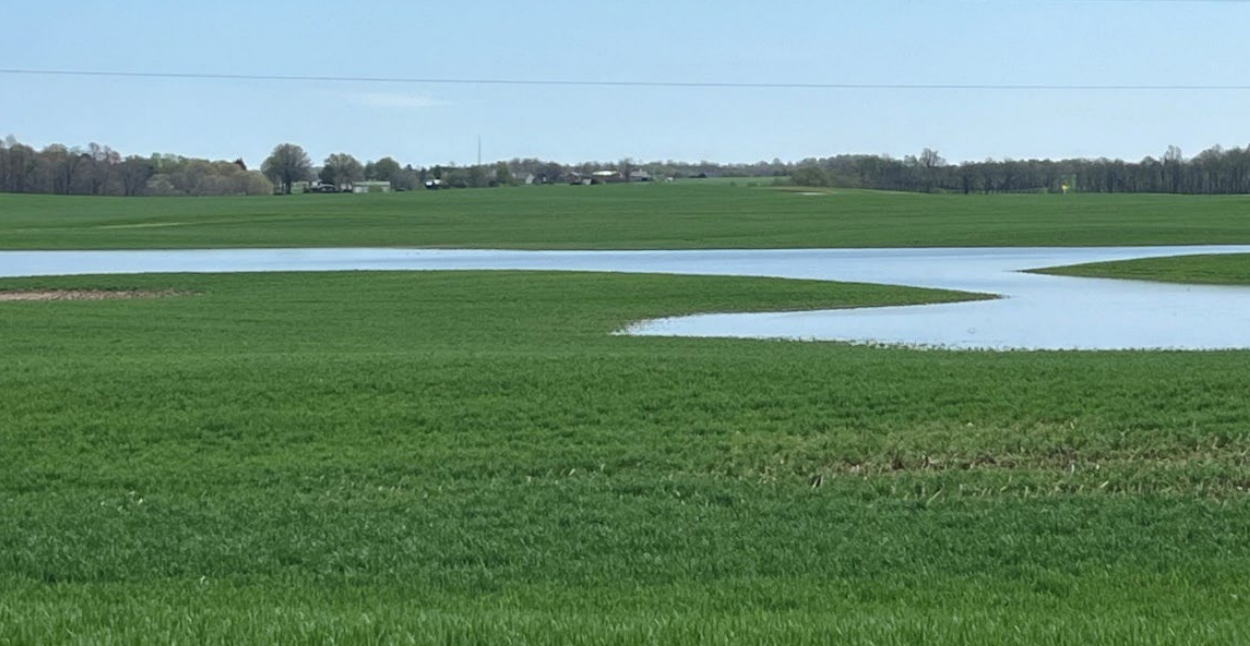Flooding and Freezing Effects on Wheat and Corn
Flooding and Freezing Effects on Wheat and Corn

Articles in this newsletter address the rainfall totals received since the first of April and the expected nitrogen losses from those conditions. There are other concerns about how the wheat crop will recover from the excessive rains. The following are some expectations and assumptions. Be cautious with these. Scouting fields around 7 to 14 days after the heavy rains (or after water recedes) will provide much better answers than the assumptions that follow.
Wheat
Wheat fully underwater for several days most likely will not survive. In corn and soybeans, we expect 24 hours of submersion at air temperatures above 70°F to cause plant death. The weather was much cooler for wheat during this flooding, and we do not have the same estimates on plant survival. Scouting 7 to 14 days after the water recedes will better identify if wheat will survive. Wheat covered in mud from receding flood waters will have a poor chance of survival. Another rain event that washes the mud off the plants could help, but it is not likely. Wheat on saturated soil but not submerged will be the hardest to scout. Again, waiting 7 to 14 days will help. The following is an expected order of events. Expected, not predicted. Saturated soils are those where water has pushed all air out of the soil. The plant roots need oxygen in the root zone to survive. The lack of oxygen in the root zone will kill the root hairs quickly, preventing the plant from taking up nutrients. Once oxygen re-enters the root zone, another three days or so are needed for new root hairs to grow and start taking up nutrients.
Meanwhile, the shoots are still conducting photosynthesis, and the plants are attempting to grow. It is very common to see a corn or soybean field flash yellow after being saturated for a while. We should expect wheat fields to do the same after several days of good growing conditions. That yellow flash has more to do with dead root hairs than a lack of nitrogen in the root zone.
Most of the wheat across the state is in the jointing stage. During these stages, the plants develop the heads that will eventually produce seeds. Nutrition disruptions during these stages could reduce head size, which could lead to reduced yields. A newsletter article from Minnesota summarizing research papers suggests that wheat in saturated conditions for more than 10 days could result in yield losses of 20 to 50% (Wiersma 2024).
On top of the flooding, most of Kentucky experienced freezing temperatures one or two nights. Those freezing temperatures likely were not cold enough to result in damage to the wheat at the current growth stages. The colder weather bracketing the freezing temperatures may have helped the wheat survive the flooding a little longer.
Corn
For corn planted just before the flooding, those seeds most likely are germinating. Four days of saturated soils will likely kill germinating corn seeds (Brehl et al. 2024). Soils saturated for one to six days could result in 6 to 61% yield loss. Expect corn emergence to be slowed, which could cause more uneven stands. Corn needs about 115 Growing Degree Days (GDDs or Heat Units) to emerge. If air temperatures are less than 50°F, then no GDDs are accumulating. If each day’s temperatures averaged 35 and 55°F for low and high air temperatures, respectively, then corn would take 20 days to emerge. Scouting corn emergence 10 to 14 days after these flooding and saturation events will provide much better clarity on corn stands.
References
Brehl, J., J. Specht, A. Nygren and N Mueller. 2024. Corn and Soybean Survival in Saturated Soils. University of Nebraska CropWatch. https://cropwatch.unl.edu/corn-and-soybean-survival-saturated-and-flooded-soils/
Lee, C., C. Bradley and K. Wise. 2023. Flooding Effect on Corn and Soybeans in 2023.
https://graincrops.ca.uky.edu/files/cornsoynewsletter2023vol05issue08aug.pdf
Wiersma, J. 2024. Wheat flooding and waterlogging. University of Minnesota.
https://extension.umn.edu/growing-small-grains/wheat-flooding-and-waterlogging#sources-798810
Citation: Lee, C.D. 2025. Flooding and Freeze Effects on Wheat and Corn.
Kentucky Field Crops News. Vol. 1 Issue 04. University of Kentucky, April 11, 2025.

